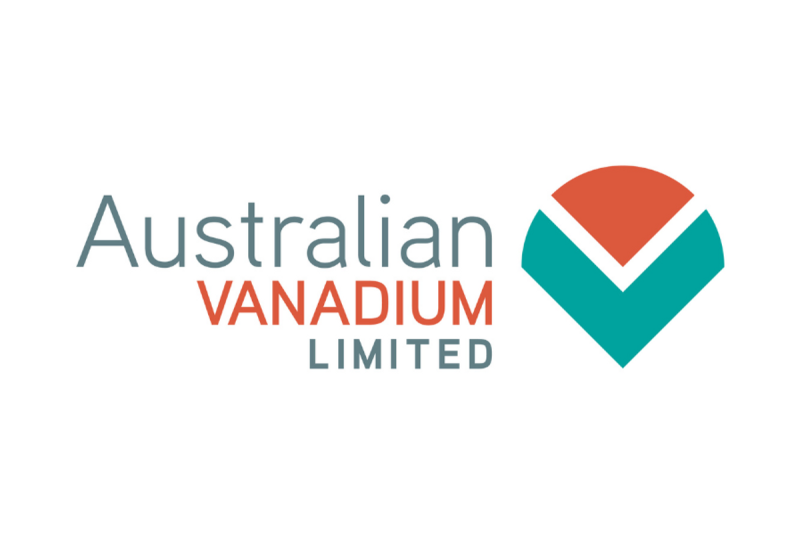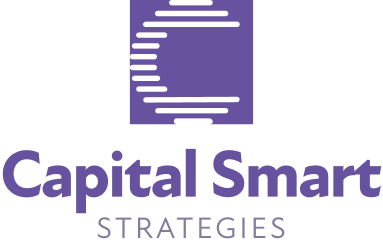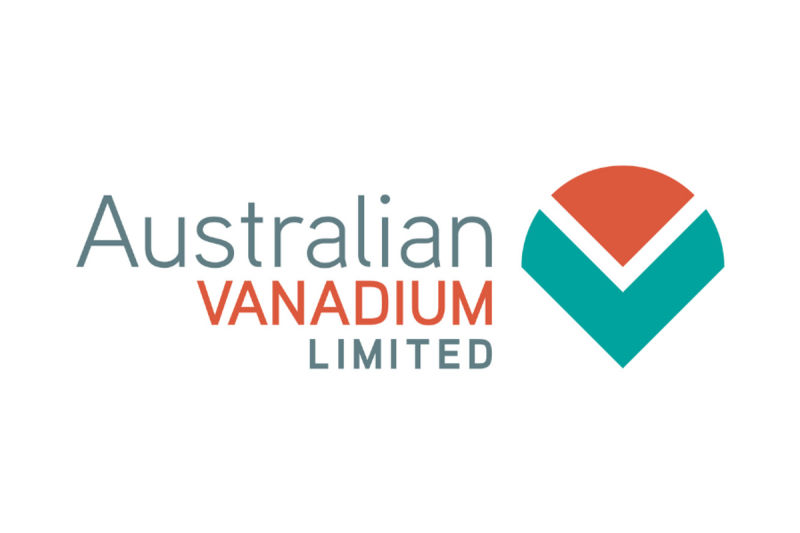
Overview
Australian Vanadium Limited (ASX:AVL) is a Western Australia-based company focused on the Vanadium supply chain, from mining to batteries. The company has a “pit to battery” strategy, which involves processing the vanadium and creating vanadium electrolytes to manufacture vanadium flow batteries (VFB) and become a VFB supplier in Australia.
AVL will generate vanadium concentrate at the mine, which will be fed to the company’s processing plant to produce vanadium pentoxide, which will then be used as feedstock for its vanadium electrolyte manufacturing facility. AVL will leverage its wholly-owned subsidiary, VSUN Energy, to create safe and reliable renewable energy storage solutions using VFB.
Currently, around 85 percent of the vanadium is sourced from China, Russia and South Africa. Vanadium is classified as a critical mineral in several countries, including the US, EU and Japan, and with its geopolitically stable environment and mining-friendly policies, Australia makes for an attractive, secure supply source.
AVL boasts a world-class vanadium asset in a tier-1 mining jurisdiction. The company’s flagship Australian Vanadium project is one of the most advanced vanadium projects in the world. The asset comprises vanadium, titanium and magnetite ore body located on wholly-owned tenements, making it scalable. The project will consist of a simple open pit mine and a processing plant, which will be close to a major port bringing lower-cost energy, water and manpower.
AVL’s recent merger with Technology Metals Australia (TMT) has provided several key benefits, including the consolidation of each company’s tenements into one big project. The merger has created a 17 kilometre strike for the high-grade magnetite domain, allowing for efficient mine infrastructure. Moreover, the merger improves the project’s economics through access to high-grade mineralization, which is now unconstrained.
A bankable feasibility study (BFS) prior to the merger had the following key parameters:
Annual production of 11,200 t V2O5Mine life of 25 yearsPre-production capex of $435 millionOpex of $4.43/lb of V2O5
Following the merger, the company is preparing an optimized feasibility study (OFS) to improve the capex and opex and deliver better project economics. The next steps for the project include a combined mineral resource estimate, publishing the OFS report, certain approvals, offtake agreements, and financing.
The demand for vanadium is expected to increase significantly due to the growth of VFBs. However, the fundamental demand for vanadium remains strong across the end markets, including its application in steel production, aerospace and energy storage. In fact, a sharp rise in demand for energy storage applications will result in a supply deficit that will grow from 2024 onwards.
Vanadium flow batteries have two tanks filled with vanadium electrolyte fuel. First invented 40 years ago, VFBs have since been commercialized for large-scale applications. The technology offers compelling cost savings for applications with greater than four hours of storage.
The VFB technology has several technological and economic merits that are driving the scale of the projects. First, it is superior economically for long-duration storage applications. Second, it is non-flammable, making it very stable. Third, it provides 100 percent depth of discharge with multiple cycles. Fourth, it offers a life span of over 25 years. Fifth, it is easy to scale. It is well proven at MWh scale and is now moving towards GWh scale.
Given these techno-economic benefits, the VFB industry is experiencing unprecedented global growth, led by China. Currently, 208 VFBs are in operation, 51 are under construction, and 87 new projects have been announced. To give an idea of this rising demand, in 2025, China alone will consume 11 times AVL’s annual production of 11,200 tons of V2O5.
The company has a well-crafted vertical integration strategy to participate across the vanadium supply chain. In addition to supplying vanadium, the company is present in the manufacturing of vanadium electrolyte and batteries.
AVL’s Vanadium Electrolyte Facility official opening by Australian Government minister for resources and Northern Australia Hon. Madeleine King MP alongside non-executive director Anna Sudlow, chair Cliff Lawrenson, CEO Graham Arvidson and non-executive director Miriam Stanborough.
AVL has completed the construction of a vanadium electrolyte manufacturing plant in Perth, Western Australia. The project has received funding from the Australian Government. The plant has a capacity of 33 MWh per annum of energy storage. The first production was completed in 2024, and VFB manufacturers will test samples. The electrolyte produced is further processed by AVL’s wholly-owned subsidiary, VSUN Energy, to create large scale energy storage solutions using VFBs.
AVL is well positioned to leverage and support VFB market growth via its vanadium electrolyte manufacturing capacity and VSUN Energy battery capabilities.
Company Highlights
Australian Vanadium Limited (AVL) is a Western Australia-based company focused on the entire vanadium supply chain, from mining to batteries. The company’s “pit to battery” strategy includes processing the vanadium to create vanadium electrolytes for vanadium flow batteries (VFB), as the company intends to become a VFB supplier in Australia.The Australian Vanadium project is the company’s flagship mining project and is one of the most advanced projects globally. The company recently completed its merger with Technology Metals Australia (TMT), which is likely to significantly boost the project’s economics. The company is working on the project’s optimized feasibility study (OFS) report. Given that only three countries (Russia, China and South Africa) contribute 85 percent of the global supply of vanadium, an Australian supply source makes the project attractive. The demand for vanadium is poised to grow across the end markets, including steel, aerospace and battery storage. Growing demand for VFBs has the potential to provide a sizable end-demand market for vanadium. Vanadium demand from batteries could reach 50 percent of the total demand by 2030, from the current share of just 7 percent.The company has a well-crafted vertical integration strategy. In addition to vanadium supply, it is also focusing on vanadium electrolyte manufacturing and the supply of VFBs to the Australian market.VSUN Energy, AVL’s subsidiary, creates safe and reliable renewable energy storage solutions using vanadium flow battery technology.
Key Operating Segments
Exploration
The segment comprises the Australian Vanadium project and other exploration projects.
Australian Vanadium Project
The Australian Vanadium project is the company’s flagship asset and one of the most advanced vanadium projects in the world. The Australian government recognized the project, which received federal major project status.
The project consists of high-grade V-Ti-Fe deposits located in Murchison Province, around 43 kilometres from the mining town of Meekatharra in Western Australia. It is around 740 kilometres from Perth, and a processing plant is located near the port city of Geraldton. The project comprises 15 tenements and spans an area of 200 square kilometres.
Before its merger with TMT, the company released a bankable feasibility study in 2022, showing a total mineral resource estimated at 239 million tons (Mt) at 0.73 percent of V2O5. The project IRR stands between 16.1 percent and 26.9 percent based on various price assumptions.
Following the merger with TMT, the company anticipates better project economics, given that it will now have easy access to the ore body’s high-grade areas, which was previously constrained. Prior to the merger, TMT tenements at the northern end of the ore body and a small block at the southern end were surrounded by AVL’s tenements, which constrained the development. The merger has created 17 kilometres of strike for the high-grade magnetite domain and allows for efficient mine infrastructure.
Coates Project – Vanadium, PGE, Nickel and Copper
The Coates project is a non-core project for the company. The project is 60 kilometres east of Perth in the Shire of Wundowie. A significant discovery of Ni-Cu-PGE by Chalice Gold Mines is just 20 kilometres from the company’s tenement, which covers an area of 111.6 square kilometres, with new applications adding 52.6 square kilometres to the area. Historic exploration of the project focused on iron-titanium-vanadium. The focus was the recovery of vanadium-titano-magnetite concentrate for use in the historical Wundowie smelter.
Nowthanna Hill – Uranium and Vanadium
Nowthanna Hill is a non-core project for the company located 50 kilometres south of Meekatharra in Western Australia, where vanadium and uranium are co-mineralized. The project resource estimate was completed in 2019. Based on 250 parts per million (ppm) V2O5 cut-off, the inferred mineral resource stands at 3.2 Mt at 334 ppm V2O5. Based on 200 ppm U3O8 cut-off, the inferred mineral resource stands at 4.22 Mt at 409 ppm U3O8.
Energy storage
This segment comprises AVL’s wholly-owned subsidiary, VSUN Energy, which develops safe and reliable renewable energy storage solutions using VFB technology. VSUN Energy is focused on developing the Australian market for VFB, and utilizes VFB technology from various global OEMs, including Invinity Energy Systems, CellCube, Sumitomo and VFlow Tech.
The company is working on several projects for VFBs in Australia, including:
Horizon Power – 78 kW/220 kWh pilot project in Kununurra, WAIGO – supply and installation of an 80 kW/300 kWh VFB at Nova Nickel OperationVictoria – supply and installation of a 20 kW/80 kWh VFBManufacture of a prototype residential 5 kW/15 kWh VFBWater Corporation – successful completion of trial of a 5 kW/30 kWh VFB
Electrolyte Plant
This segment comprises AVL’s vanadium electrolyte manufacturing facility in Western Australia. The facility was successfully and safely completed in December 2023. It was made possible with support from the federal government, which awarded AVL a $3.69 million Australian Government Modern Manufacturing Translation grant in 2021 under the National Manufacturing Priority Roadmap.
The facility can support 33 MWh of VFB energy storage per year, and AVL has the capability to expand conveniently. By sourcing electrolyte locally, AVL aims to establish itself as a reliable provider of vanadium electrolyte for battery projects not only in Australia but also across the broader region.
Management Team
Cliff Lawrenson – Non-executive Chairman
Cliff Lawrenson has a decade of experience as a chairman and director of both private and public companies. Currently, he serves as chairman of Paladin Energy, Caspin Resources and Pacific Energy. Previously, he held senior leadership roles at various companies in the mining and mining services sectors.
Daniel Harris – Non-executive Director
Daniel Harris has a B.Sc. degree and has rich experience in the vanadium industry in the technical and financial domains. He is currently a director Queensland Energy & Minerals, and Flinders Mines. Previously, he held senior leadership roles at U.S Vanadium, Atlas Iron, Atlantic, Evraz Group, Vametco Alloys and Strategic Minerals.
Miriam Stanborough – Non-executive Director
Miriam Stanborough has a degree in chemical engineering and has over two decades of experience in the mineral processing industry. She has held senior leadership roles at Alcoa, Monadelphous, Iluka Resources and WMC Resources. She currently serves on the boards of Pilbara Minerals and BCI Minerals, and is a chair of the Minerals Research Institute of Western Australia.
Peter Watson – Non-executive Director
Peter Watson has a degree in chemical engineering and has over four decades of rich experience in various domains at several ASX-listed companies. He is a director of Paladin Energy, New Century Resources and Strandline Resources.
Anna Sudlow – Non-executive Director
Anna Sudlow has a B. Com degree, a CPA designation, and an MBA. She is a senior finance executive with rich experience in the mining and resources sector. She is currently CFO at Paladin Energy.
Jo Gaines – Non-executive Director
Jo Gaines has a BA degree from the University of Western Australia, a diploma in Occupational Health and Safety from Curtin University, and is also a graduate of the Australian Institute of Company Directors. She has previously served as deputy chief of staff for the Premier of Western Australia. She currently serves as a chair of the Government Employees Superannuation Board and is also associated with Chalice Mining, CinefestOZ and Gaines Advisory.
Graham Arvidson – Chief Executive Officer
Graham Arvidson has over 18 years of experience in the minerals sector, working with commodities such as vanadium, nickel, lithium and others. He also has rich project development experience, covering various areas such as managing contracts, tendering, negotiations, O&M and project delivery.
Todd Richardson – Chief Operating Officer
Todd Richardson has a B.Sc. degree and an MBA. He has over two decades of experience in the vanadium industry across various domains such as design, commissioning and operations. He has rich experience in operations management and technical services in the US and Australia.
Louis Mostert – Chief Legal and Commercial Officer
Louis Mostert has a bachelor’s degree in engineering and law from the University of Western Australia, and a diploma from the Governance Institute of Australia. He has over two decades of rich experience across various functions such as project finance, M&A, corporate advisory, insurance, work health and safety, governance, and compliance.
Tom Plant – Chief Financial Officer
Tom Plant is a qualified chartered accountant with an MBA from INSEAD, an M.Sc. degree from Curtin University, and a B.Com. degree from the University of Western Australia. He is a seasoned finance professional with over thirty years of experience in corporate and commercial roles.
Ross Jennings – Chief Safety and People Officer
Ross Jennings has formal qualifications in health & safety, environmental management and HR. He has over 18 years of experience in the mining industry, holding leadership roles across various functions such as operations, health, safety and emergency response.
Flormirza Cabalteja – Executive General Manager: Project Delivery – Downstream
Flormirza Cabalteja has a degree in chemical engineering with 17 years of rich experience in the downstream refinery industry of vanadium, cobalt, nickel and ammonium phosphate-based fertilizers. She has extensive experience in both technical management and operational aspects.
Ian Prentice – Executive Integration
Ian Prentice has a B.Sc. degree in geology from the University of Western Australia and has over three decades of experience in the global mining industry.
This profile was written in collaboration with Couloir Capital.

